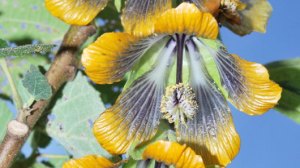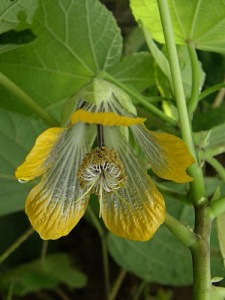Abutilon ranadei is critically endangered species of ornamental flower of Maharashtra where it is called Ghanti Mudra or Son Ghanta. It was first collected at Amba Ghat in the Kolhapur District of Maharashtra State by Namdeorao B. Ranade, who was the keeper of the Herbarium at the College of Science, Pune. Kew botanist Otto Stapf and G.M. Woodrow described it as a new species in 1894 and named it in honour of Mr Ranade.
Because of its narrow range and extreme rarity, in the past it has been rated as Endangered or even presumed extinct, and has only recently been assigned to the critically endangered category. In addition to its type locality, it has now been collected in nine new locations: in Pune (Shilimb, Rajgad, Torna Fort, Purandhar Fort), Satara (Vasota Fort), Sangali (Gothne, Prachitgad), Kolhapur (Radhanagari), and Sindhudurg (Amboli) Districts of Maharashtra State.
It is an undershrub, measuring 2.5-3.5 m high. The vegetative plant parts bear star-shaped hairs. The leaves are ovate to rounded-ovate, with tips that taper to a point, heart-shaped bases and scalloped to toothed margins. The solitary flowers are about 2.5 cm in diameter. The calyx is bell-shaped, with lobes free up to the middle, and is covered with glands and star-shaped hairs. The corolla is bell-shaped with pale purple petals with orange-yellow tips. The petals are twice as long as the calyx. The staminal column is 2-3.5 cm long and is hairless with purple lines. The filaments are white with a reddish base, 3-5 mm long, and have dumbbell-shaped glandular hairs in the upper part. The anther lobes are kidney-shaped and are initially green, turning dark rose at maturity and brownish-violet at dehiscence. There are five styles, which are up to 7 mm long and sparsely hairy. The five carpels have a sharp point and are densely hairy throughout. The fruits are schizocarpic (split into a number of seed-containing parts).
The species has danger of extinction from natural as well as man made threats. Anthropogenic threats include the periodic harvesting of firewood from the edges of the forests where it occurs, forest fires, and the collection of Strobilanthes callosa stems for house-building and agricultural practices, which disturb the habitat of this dwindling species. A. ranadei also faces natural pests such as tropical red spider mites, striped mealy bugs, cabbage semi-loopers, aphids, purple scale insects, leaf miners and snails. Amongst the known natural pests, mealy bugs present the most common threat.


Write up is good, but photo credit should be given